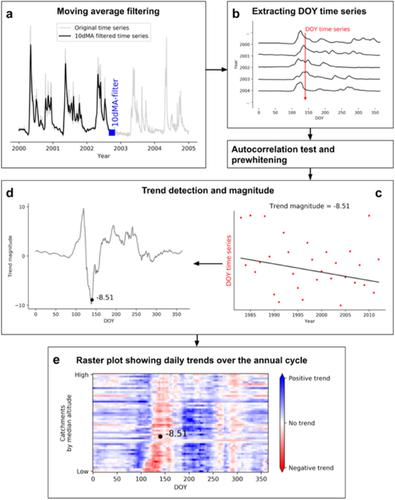当前位置:
X-MOL 学术
›
Hydrol. Process.
›
论文详情
Our official English website, www.x-mol.net, welcomes your feedback! (Note: you will need to create a separate account there.)
Daily streamflow trends in Western versus Eastern Norway and their attribution to hydro-meteorological drivers
Hydrological Processes ( IF 3.2 ) Pub Date : 2021-08-01 , DOI: 10.1002/hyp.14329 Amalie Skålevåg 1 , Klaus Vormoor 1
Hydrological Processes ( IF 3.2 ) Pub Date : 2021-08-01 , DOI: 10.1002/hyp.14329 Amalie Skålevåg 1 , Klaus Vormoor 1
Affiliation

|
Regional warming and modifications in precipitation regimes has large impacts on streamflow in Norway, where both rainfall and snowmelt are important runoff generating processes. Hydrological impacts of recent changes in climate are usually investigated by trend analyses applied on annual, seasonal, or monthly time series. None of these detect sub-seasonal changes and their underlying causes. This study investigated sub-seasonal changes in streamflow, rainfall, and snowmelt in 61 and 51 catchments respectively in Western (Vestlandet) and Eastern (Østlandet) Norway by applying the Mann–Kendall test and Theil–Sen estimator on 10-day moving averaged daily time series over a 30-year period (1983–2012). The relative contribution of rainfall versus snowmelt to daily streamflow and the changes therein have also been estimated to identify the changing relevance of these driving processes over the same period. Detected changes in 10-day moving averaged daily streamflow were finally attributed to changes in the most important hydro-meteorological drivers using multiple-regression models with increasing complexity. Earlier spring flow timing in both regions occur due to earlier snowmelt. Østlandet shows increased summer streamflow in catchments up to 1100 m a.s.l. and slightly increased winter streamflow in about 50% of the catchments. Trend patterns in Vestlandet are less coherent. The importance of rainfall has increased in both regions. Attribution of trends reveals that changes in rainfall and snowmelt can explain some streamflow changes where they are dominant processes (e.g., spring snowmelt in Østlandet and autumn rainfall in Vestlandet). Overall, the detected streamflow changes can be best explained by adding temperature trends as an additional predictor, indicating the relevance of additional driving processes such as increased glacier melt and evapotranspiration.
中文翻译:

挪威西部与东部的每日流量趋势及其对水文气象驱动因素的归因
在挪威,降雨和融雪都是重要的径流生成过程,区域变暖和降水状况的改变对水流有很大影响。最近气候变化的水文影响通常通过应用于年度、季节性或月度时间序列的趋势分析进行调查。这些都没有检测到次季节性变化及其根本原因。本研究通过应用 Mann-Kendall 检验和 Theil-Sen 估计器对 10 天移动平均每日分别调查了挪威西部 (Vestlandet) 和东部 (Østlandet) 61 个和 51 个流域的水流、降雨和融雪的次季节变化30 年(1983-2012 年)的时间序列。降雨与融雪对每日径流的相对贡献及其变化也已被估计,以确定这些驱动过程在同一时期的变化相关性。检测到的 10 天移动平均每日流量的变化最终归因于最重要的水文气象驱动因素的变化,这些驱动因素使用越来越复杂的多重回归模型。由于融雪较早,这两个地区的春季流动时间较早。Østlandet 显示在海拔高达 1100 m 的集水区夏季流量增加,在大约 50% 的集水区中冬季流量略有增加。Vestlandet 的趋势模式不太一致。降雨在这两个地区的重要性都增加了。趋势归因表明,降雨和融雪的变化可以解释一些以它们为主导过程的水流变化(例如,Østlandet 的春季融雪和 Vestlandet 的秋季降雨)。总的来说,检测到的水流变化可以通过添加温度趋势作为额外的预测因子来最好地解释,表明额外驱动过程的相关性,如冰川融化和蒸发蒸腾增加。
更新日期:2021-08-19
中文翻译:

挪威西部与东部的每日流量趋势及其对水文气象驱动因素的归因
在挪威,降雨和融雪都是重要的径流生成过程,区域变暖和降水状况的改变对水流有很大影响。最近气候变化的水文影响通常通过应用于年度、季节性或月度时间序列的趋势分析进行调查。这些都没有检测到次季节性变化及其根本原因。本研究通过应用 Mann-Kendall 检验和 Theil-Sen 估计器对 10 天移动平均每日分别调查了挪威西部 (Vestlandet) 和东部 (Østlandet) 61 个和 51 个流域的水流、降雨和融雪的次季节变化30 年(1983-2012 年)的时间序列。降雨与融雪对每日径流的相对贡献及其变化也已被估计,以确定这些驱动过程在同一时期的变化相关性。检测到的 10 天移动平均每日流量的变化最终归因于最重要的水文气象驱动因素的变化,这些驱动因素使用越来越复杂的多重回归模型。由于融雪较早,这两个地区的春季流动时间较早。Østlandet 显示在海拔高达 1100 m 的集水区夏季流量增加,在大约 50% 的集水区中冬季流量略有增加。Vestlandet 的趋势模式不太一致。降雨在这两个地区的重要性都增加了。趋势归因表明,降雨和融雪的变化可以解释一些以它们为主导过程的水流变化(例如,Østlandet 的春季融雪和 Vestlandet 的秋季降雨)。总的来说,检测到的水流变化可以通过添加温度趋势作为额外的预测因子来最好地解释,表明额外驱动过程的相关性,如冰川融化和蒸发蒸腾增加。



























 京公网安备 11010802027423号
京公网安备 11010802027423号